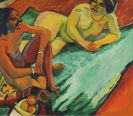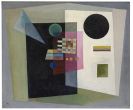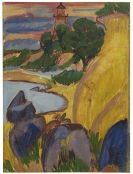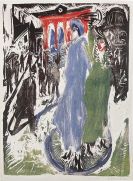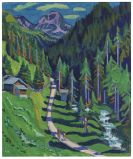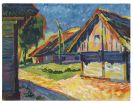
Alfons Walde
Oberndorf
1891 -
Kitzbühel
1958
Alfons Walde's first watercolour and tempera paintings already emerged during his schooldays. From 1910 to 1914 Walde studied architecture at the Technische Hochschule in Vienna and at the same time continued his education as a painter. In the Danubian metropolis he found an important supporter in the architect Robert Örley, who made the Vienna art scene accessible for him. He moved in artistic circles that included Egon Schiele and Gustav Klimt and he was influenced by Ferdinand Hodler. In 1911 he had his first exhibition in Innsbruck, in 1913 he was already represented by four farm pictures at the exhibition of Vienna's Secession.
From 1914 to 1917 he actively participated as a Tyrolean Kaiserschütze in the high mountains battle of world war I. Afterwards he continued his studies at the Technische Hochschule in Vienna, but soon returned to Kitzbühl.
In Kitzbühl he fully devoted himself to painting and participated again in exhibitions of the Secession and the Wiener Künstlerhaus in the 1920s. In 1924 he received the first and second prize at the competition "Winterbilder" [winter pictures] and took part at the Biennale Romana in Rome in 1925. Around 1928 he finally found his own characteristic style that gave expression to the Tyrolean mountain scenery - particularly the living winter landscapes - and its robust people through the use of highly reduced inland drawings and a pastose colouring. Together with Rudolf Stolz from Bozen he received the first prize for the design of the arrangement of the main station's hall in Innsbruck.
The late 1930s were a difficult time for Walde: in 1938 the Gestapo came to his house several times and he was incarcerated for two months after defamation. After the war, Walde dealed with new architectural projects: in 1946 with the design and new plans of the mountain station hotel at the Hahnenkamm, in 1948 with plans for a new school building and in 1953 he created a design for his parents' tomb on the new cemetery in Kitzbühl.
In 1956 Walde was invested as professor as a late official recognition of his artistic work. His last years were marked by strokes of fate and illnesses. In his work, he once more turned to painting and flower paintings, nude drawings and small winter and sport motifs in tempera came into existence. The artist died in Kitzbühl in 1958.
As a painter, architect, graphic artist and publisher, Alfons Walde formed the Tyrolean art of the first half of the 20th century in an important way.
Would you like to sell a work by Alfons Walde?
Infos for seller

